In our last post, we talked about the power of a strong brand experience. Today we’re looking at the visual symbol of that brand experience, the logo. Logo design and development is a big undertaking. I have heard people say it’s like giving birth. I won’t speak to the accuracy of that comparison – everyone’s experiences are different. But let’s just say…it’s major.
A logo is a simplified representation of an entire organization. Some of the most effective logos are clean and simple, but make the viewer look deeper. (The use of negative space in the FedEx logo is one of our favorite examples of this.) Your logo should be something you are prepared to live with for a long time, because once you have it, and people associate it with your brand, changing it can be as large an undertaking as designing it in the first place.
If you are in the market for a new logo, or a logo redesign, here are some things to consider as you begin the design process.
Your logo matters. I asked our designer Nissa Grayson, how she would respond to someone who feels a logo doesn’t really matter. “A logo is a baseline. It sets the tone for all design decisions that follow it, for your website, print pieces, and any other branding. As people, we are visual, and we are distracted. We tend to gravitate toward images that we latch on to and connect with. That visual perception can be the first opportunity to grab attention, and set your brand apart from dozens of others doing the same type of work you do. There is real value in that ability to stand out and get noticed.”
A proper logo is an investment. If you are looking for someone to design a logo for you, please don’t begin by Googling something like “logo design free.” There are crowd-sourcing logo design contest websites out there, but we don’t recommend them, and here’s why: In general, designers on those sites crank out concepts left and right, trying to make a sale. That is the main motivation. It is very difficult for them to truly understand or care about your business, which is an integral part of the logo design process.
It’s best to financially commit to doing it right and starting strong, rather than having to re-do your logo later. (You will probably save money in the long run.) On a budget? Get creative! Ask for referrals for a designer who may be willing to trade services. Take up a couple of side projects and earmark the funds for your logo. Done right, it will be money you’ll be glad you spent.
Be ready to be thoughtful. Logo design is a process with multiple steps. Your designer can’t create a symbol of your organization without understanding that organization first. Many questions should be asked during a creative brief, about your organization’s mission, why your audience chooses you over your competition, and who your audience is. How do you want your audience to feel when they see your logo? What are your visual preferences? What colors are significant, or are definite “nos?” Because of studies about the psychology behind color, and how it can affect marketing and branding, our designer Nissa prefers to develop a logo in grayscale first, to lock in preferred graphic elements, and then add color. “People can have strong reaction to color, and eliminate a logo concept that might be the right fit for them, because they are reacting to a color they don’t like.”
Let the designer revise it. If you’re not drawn to any of the logo concepts you are presented with, this may indicate a problem with communication during the creative brief process. However, if you see potential in the concepts, but none of them feel like “it,” explain your point of view, and let the designer take it from there. Offer feedback that is descriptive rather than prescriptive. Also, steer clear of design by committee. Ever heard of “too many cooks in the kitchen”? That definitely applies to looking at design concepts. Too many opinions can quickly derail a solid design and burn through hours of unnecessary revisions.
What’s your opinion? Do you think a logo is as important as we think it is? What logos do you think are really strong (or don’t you like at all?) We love hearing from you – speak up in the comments and let’s start a conversation!




